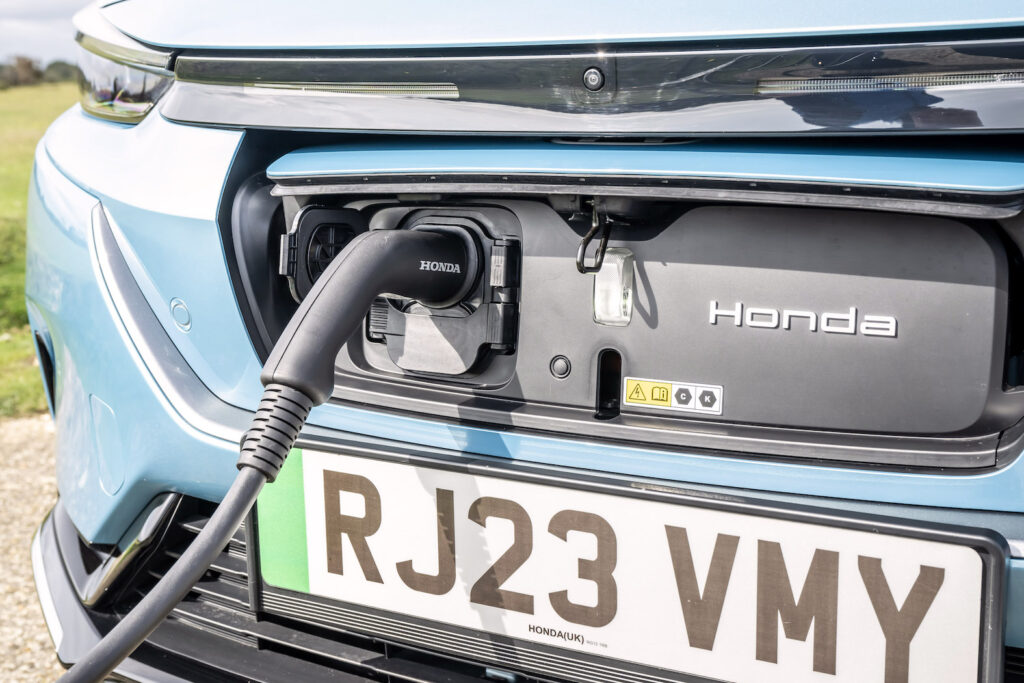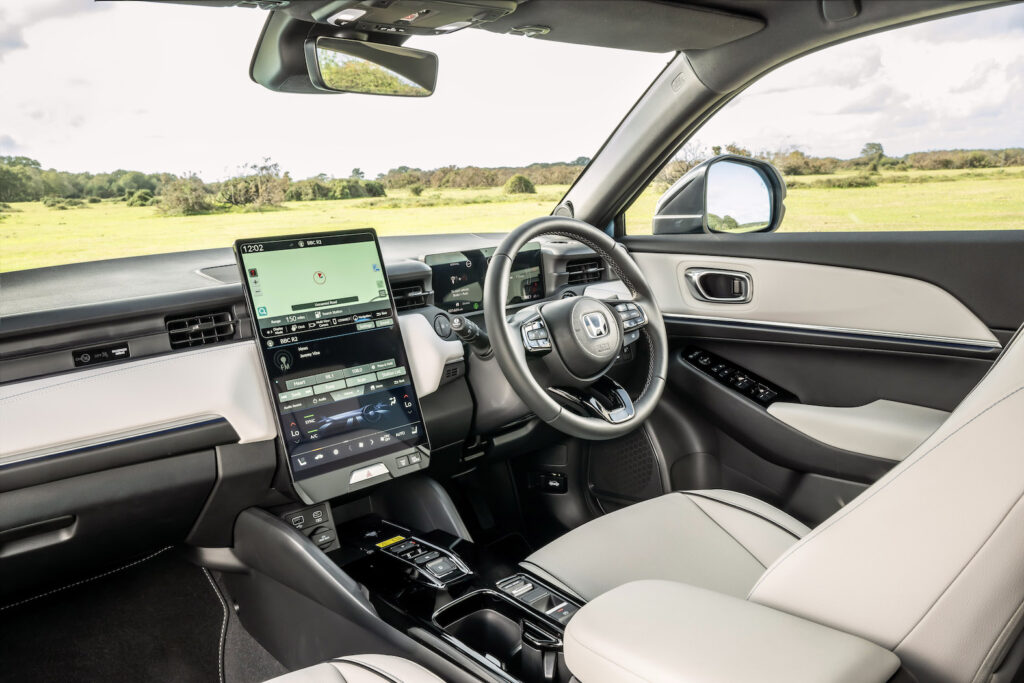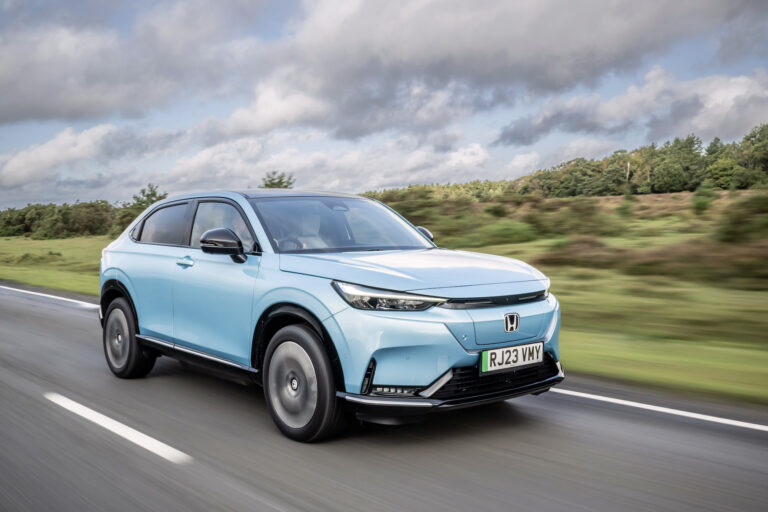Honda has an odd relationship with electric cars. Having led the way with the original Insight and then various mild-hybrid technologies and even the fuel-cell FCX Clarity, it seems to have, well, dropped the ball.
Other car manufacturers, particularly Kia and Hyundai, have instead picked up the baton and run with it to great success and all that Honda has to show for it is the city-based Honda e. So it’s fair to say that this new and oddly-named all-electric eNY1 is rather eagerly awaited.
Slightly longer and taller than the HRV elsewhere in the Honda showroom, though visually very similar, Honda is open in aiming the eNY1 at those first-time EV customers and, in many ways, that shows, as we’ll see. The nearest rivals for the eNY1 are the likes of the Kia Niro, Hyundai Kona and Toyota bZ4X.
HONDA eNY1 – DESIGN

As we said, while it’s similar to the HRV, the eNY1 is certainly not a bad looking car. While it lacks the cute styling cues of the smaller Honda e, it has conservative styling that won’t turn many heads, but thankfully won’t turn many stomachs either.
The front with the large charging port door looks a bit slab-sided, but the shallow-raked rear screen and hidden rear door handles, give it a semi coupe-ish look and we like the multi-spoke wheels (even though they look a pain to clean). There’s also a smart light strip across the rear and over-sized Honda lettering as seen on Skoda (although it niggles that this is upper and lower case, yet the official Honda logo is all in capitals).
HONDA eNY1 – POWER AND RANGE

Unlike other EVs on the market, Honda has kept it simple with the eNY1 with just one battery choice. It’s a 68.8kWh (the equivalent of 204bhp) with a 256 mile range available in Elegance and Advance trim. By comparison, the Kia Niro offers a slightly smaller battery, but more range.
Both models have the same 7.6 second 0 to 60mph time and 100mph top speed with two-wheel drive and a 11kW on-board charger. Honda claims a 3.41ml/kWh efficiency which we almost matched with 3.3mls/kWh without much effort during our test drive. And while it’s good news that we almost matched the officially claimed figure, we’d expect better from what is, after all, not a huge car.
Honda claims its possible to recharge from 10 to 80% in 45 minutes with the same period taking six hours on a home charger. It also claims that the eNY1 has a special recharging system enabling a higher charge rate over its rivals, while retaining battery durability.
For home charging Honda will also offer its eProgress app on subscription that works with its approved charger provider. This allows eNY1 drivers to charge using Octopus Go and Octopus Agile tariffs, though not the popular Intelligent tariff.
For us this feels a bit illogical as few novice EV drivers such as those that Honda is aiming the eNY1 at are likely to be confident enough to have the Agile tariff, while Go’s four hours will only charge half the eNY1’s battery. Worse still, the eProgress app will cost £75 per year and yet the charger costs the same as better smart chargers on the market with the same charging technology but without an ongoing subscription. It feels a bit like Honda taking advantage of those novice drivers who don’t do their own homework on better chargers on the market.
Also, the central, nose-based charging port means you’ll have to drive front in at any charging points. While that makes it easier for a cable to reach, it does mean you can’t back in to a parking space, which many people prefer.
HONDA eNY1 – ON THE ROAD

At 1733kg, the eNY1 isn’t exactly heavy, but it’s hardly light either and that shows on the road. It can feel a little cumbersome and heavy to react to steering inputs while there’s a strange disconnect with the feel of the steering itself and what the car is actually doing. That weight is obvious in corners too where there’s a bit of bodyroll too.
Ok, so that’s the bad news. The good is that on the standard 18-inch wheels, the eNY1’s ride quality is pretty good, keeping road imperfections and bumps from the occupants and making it a pretty comfortable place to be.
That’s just as well too as some of the eNY1’s EV tech and how it works is just plain odd to us. So there are Eco, Normal and Sport driving modes and then there are three different levels of regenerative braking accessed via the steering wheel paddles.
Under normal circumstances, you’d expect the right-hand paddle to increase the level of regen and the left hand one to reduce it. Except what actually happens is that the right-hand paddle will get you to level one, but then you have to use the left-hand paddle to get to levels two and three.
But that turns out to be just the start because the eNY1 doesn’t actually retain that level of regen and forgets it soon afterwards. Furthermore, there’s very little perceptible difference between each level (though the Eco driving mode does increase it) and none of them offer an aggressive one-pedal driving style mode as with almost every other EV on the market (including, ironically, the Honda e with its Single Pedal Control)
This isn’t Honda’s first EV and you have to assume its engineers have tested and driven all the rivals on the market, so why come up with a system that’s not remotely intuitive and at odds with what every other EV on the market offers? Strange.
HONDA eNY1 – INTERIOR

The eNY1’s interior is dominated by a Tesla-style large portrait screen in the centre of the dashboard. However, its size is a little deceptive as Carplay only shows in the top half of that screen, with the remainder left for other functions.
The rest of the inside feels typical Honda which is to say very functional and faultless build quality but lacking any real flair or design touches. Again, park it alongside the Honda e in the showroom and you’d be left wondering if they were from the same company. Yes, the eNY1 is aiming at a very different audience, but nobody doesn’t like a bit of design flair here and there.
But while it may be lacking flair, that doesn’t mean it’s without idiosyncracies mind you. The Advance gets a panoramic roof which isn’t truly panoramic as it’s split into a standard sunroof-sized window above the front passengers and two glass panels above those in the rear. Those two glass panels in turn have slightly odd clip-in fabric panels too, which would have to be stored in the boot and you’d imagine would be lost easily in time. Again, it feels like an oddly impractical solution introducing problems where normally they wouldn’t exist.
Talking of the boot too, it’s reasonable rather than amazing at 361 litres (up to 1176 litres with the seats down), though also has a now-typical, horrid fabric rear parcel shelf.
Talking of practicalities, we also wouldn’t mind the seats being slightly more supportive and also the steering wheel to have more reach adjustment. Despite offering height and reach adjustment, the latter is very limited compared to most modern cars. There’s decent rear space for adults though.
SUMMARY
For a loyal Honda customer (and many are), the eNY1 will probably be a perfectly good entry step into the EV market. While it’s not outstanding in any particular area, it’s also not overly offensive in any of them either. It looks ok, it drives ok and overall it is, well, ok.
The problem comes however is you remove the Honda blinkers and look in at the eNY1 in detail or compare it to direct rivals, where it comes a little more unstuck. Others offer more range, better efficiency or better value and EV drivers have already shown that they’re less loyal than buyers have been traditionally.
There’s also seeming own goals from Honda too, such as the odd regenerative braking system or the choice to charge £75 a year for smart charging technology which is easily available elsewhere on the market with alternative charger choices – rather cheeky in our view.
In essence then, there’s nothing strictly wrong with the eNY1 and it’s a perfectly good new entrant into the EV market, it’s just that others offer a lot more for the same, or less, money.

FACT BOX
Model: Honda eNY1
Price: from £44,995
Power: Battery – 68.8kWh
Range: 256 miles
Average efficiency: 3.3mls/kWh
Average charge time on a domestic wallbox: 9-10hrs
CO2 emissions: 0g/km
Rating: 6/10

